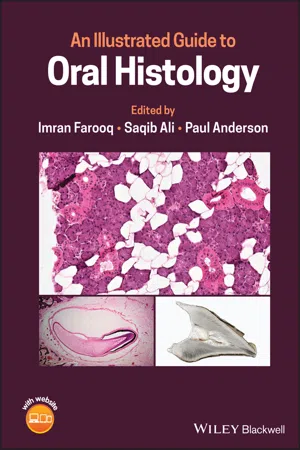
An Illustrated Guide to Oral Histology
- English
- ePUB (mobile friendly)
- Available on iOS & Android
An Illustrated Guide to Oral Histology
About this book
An Illustrated Guide to Oral Histology
Learn more about the histological presentation of diseased and normal oral tissues with this high definition illustrated dental reference
An Illustrated Guide to Oral Histology delivers a collection of high-definition histological and pathological images, presenting both diseased and normal oral tissues.
The book provides over 200 high-magnification histomicrographs of oral tissues, as well as definitions and explanations of key identifying histological and pathological features of oral tissues. Readers will also benefit from explanations of the clinical significance of particular features, numerous images of ground sections, haemotoxylin- and eosin-stained sections, and electron images. It also includes core topics such as:
- An introduction to tooth development, including the bud, cap, early bell, and late bell stages
- A thorough exploration of enamel, dentin, cementum and dental pulp
- A discussion of the periodontal ligament, including alveolar crest fibers, horizontal, oblique, apical, and inter-radicular fibers, transseptal fibers, and gingival fibers
- A guide to alveolar bone, oral mucosa, and salivary glands
Perfect for postgraduate dental students, An Illustrated Guide to Oral Histology will also be useful to undergraduate dental students, and those looking to improve their understanding of the microscopic structure of dental tissues and their pathologies.
Frequently asked questions
- Essential is ideal for learners and professionals who enjoy exploring a wide range of subjects. Access the Essential Library with 800,000+ trusted titles and best-sellers across business, personal growth, and the humanities. Includes unlimited reading time and Standard Read Aloud voice.
- Complete: Perfect for advanced learners and researchers needing full, unrestricted access. Unlock 1.4M+ books across hundreds of subjects, including academic and specialized titles. The Complete Plan also includes advanced features like Premium Read Aloud and Research Assistant.
Please note we cannot support devices running on iOS 13 and Android 7 or earlier. Learn more about using the app.
Information
1
Tooth Development

1.1 Bud Stage


1.1.1 Description
1.1.2 Key Identifying Features
1.1.3 Clinical Significance
1.2 Cap Stage


1.2.1 Description
Table of contents
- Cover
- Table of Contents
- Title Page
- Copyright Page
- Preface
- Sample Preparation
- About the Editors
- List of Contributors
- About the Companion Website
- 1 Tooth Development
- 2 Dental Enamel
- 3 Dentin
- 4 Cementum
- 5 Dental Pulp
- 6 Periodontal Ligament
- 7 Alveolar Bone
- 8 Oral Mucosa
- 9 Salivary Glands
- Index
- End User License Agreement